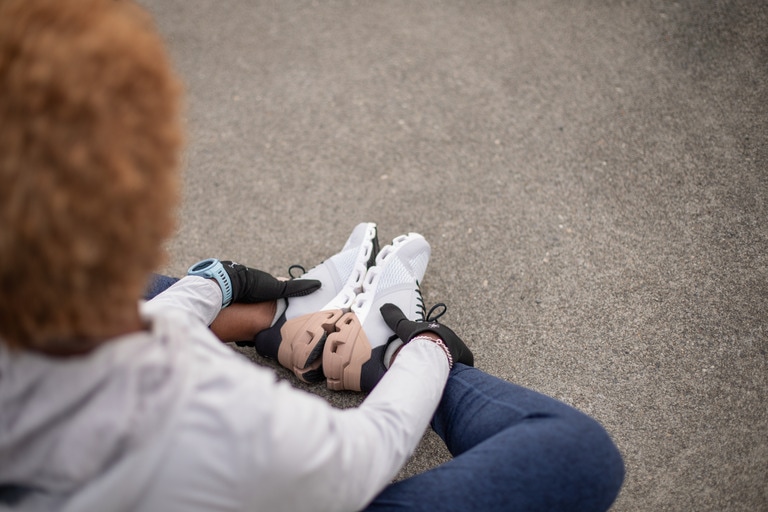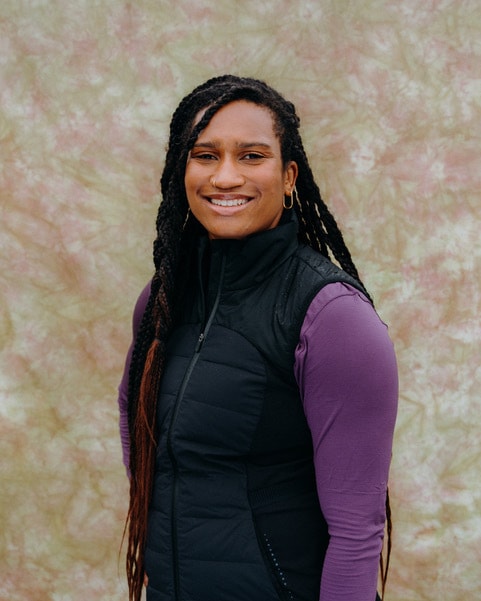The social media images we often see belie a stark reality: Each year in the United States, the outdoor community an average of 8.6 million recreation-related injuries. Despite its commonality, injury isn’t often broadcast , nor do we discuss how being injured can challenge our relationship to the outdoors. It’s harder to participate in the activities we love when we’re hurt, healing or otherwise out of commission.
It can be easy to find information about preventing and physically recovering from injury, but less is known about dealing with the psychological experience of being sidelined from an activity you love. There’s a common refrain among the coaches, athletes, and experts I spoke with: There isn’t one right way to deal with injury—but spending time on the mental process can help you deepen your relationship to the outdoors, and yourself.
Tim Brown was working on ski patrol in Snowmass, Colorado, when a 2011 ski accident left him paralyzed and quadriplegic. At 25, Brown was an avid surfer, snowboarder and skier. The incident left him reeling. He wondered if he’d return to sports, and whether he could even call himself a member of the outdoor community any longer.
“For almost two years after I was paralyzed, I didn’t feel like I had the right to wear a hat with a surf brand logo on it because I couldn’t paddle out and stand up on a wave on my own,” he says. “It was so ingrained in me that to be an outdoorsperson, you have to be able-bodied and active outside.”
Whether the injury is temporary, like a broken bone, or permanent, like paralysis, the experience can force us to interrogate our relationship to our sport as we consider our body’s limitations and how our relationship to the kinds of activities we like to do might change.
“Every single injury experience is unique,” says Carrie Jackson, a performance and mental training expert and cofounder of the online support group The Injured Athletes Club. What’s almost universal among athletes who become injured is that it threatens our sense of self. “For many athletes, it’s the first time they are faced with their own vulnerability and thinking, ‘I might not be able to do this forever.’”
For some, it might take weeks to accept an injury and come up with a plan for how to handle it. For others, especially for those whose injuries result in a disability, like Brown, the process can take years.
In this guide, we will discuss some of the elements that experts say contribute to bouncing back to your outdoor life after an injury:
Acknowledging Your Injury
Research into the psychology of healing from an injury is still new, but experts have found that allowing yourself to experience your feelings around your injury can help you accept the injury and move forward. That might mean processing feelings with a friend, therapist or other professional; beginning a meditation practice; journaling or getting outside a little bit each day.
Jackson, who has worked with hundreds of athletes, uses the acronymic saying “Go FAR”—feel, accept, recover—to coach recreationists through an injury and its sometimes-tricky aftermath. “You have to really allow yourself to feel all the emotions you’re feeling before you can come to a place of accepting that you’re injured,” she says, and stresses the importance of feeling them accurately. “A lot of times we’re fighting against it and not wanting to accept we’re injured. ”
The process varies for everyone. Personal and experiential factors, like an athlete’s support system or, their coping skills and whether they’ve been injured previously might influence the overall healing process.
The injury or trauma’s severity is also a significant factor. For athletes facing a life-changing, permanent disability, like Brown, the healing process looks a lot different and is more significant than for those who are predicted to make a full recovery. A spinal cord injury isn’t the same as a broken ankle. This is for physical reasons, of course, but also structural ones, including living in a society where people with disabilities continue to face discrimination as well as barriers to inclusion and employment. To this day, outdoor opportunities are often geared toward people without disabilities, failing to take into consideration accessibility and other needs, although things are changing.

Recovery Is Your Sport
Healing from injury, regardless of one’s prognosis, can become a kind of athletic pursuit itself. Craig DeMartino is an adaptive climber and the national climbing manager for Adaptive Adventures, a nonprofit organization (and REI Cooperative Action Fund grantee) that makes it easier for people with disabilities to access outdoor activities. In 2002, DeMartino experienced a 100-foot fall that led to a fused back at L1-4, fused neck at C5/6, and the amputation of his right leg below the knee. He said that recovery, for him, required following a protocol, and sticking with it.
“For me, it was like, ‘OK, this sucks.’ But also, I’m very task-oriented,” he says. “So, if my doctor told me I needed to go to the hyperbaric oxygen chamber each day, for instance, I was going to do it. It was almost like training to me.” DeMartino and his wife, Cyndy, built his treatment plan into their daily routine. DeMartino’s kids visited him every day in the hospital initially. He committed himself to physical therapy and hyperbaric oxygen therapy, which is shown to promote healing. Eighteen months after his accident, he underwent surgery to amputate his right leg below his knee, which allowed him to begin using a prosthetic. Slowly—over the course of years—DeMartino felt himself beginning to make physical and psychological progress.
Author and ultrarunner Katie Arnold describes this as the Zen Buddhist principle of “true effort,” or doing one’s best given the circumstances. In 2016, Arnold broke her leg whitewater rafting down the Middle Fork of Idaho’s Salmon River. She writes about this experience and returning to running in her book Brief Flashings in the Phenomenal World. “Zen is a practice of staying very present and making true effort in each moment,” she says. “True effort could mean prioritizing physical therapy, or doing a strength exercise. For me, it was about being intentional with my mindset and making small efforts that made me feel more like myself.”
Mindset is important. So is access to health care and support from a care team that respects you and understands your injury. “As someone who ran competitively since I was the age of 11, I pushed myself as hard as I could,” says Aaliyah Earvin, a certified run coach and the founder of North of Seattle Run Club. Earvin has cervical dystonia, a condition that can cause your neck to contract involuntarily and can lead to headaches, among other painful symptoms. Earvin struggled with confusing symptoms for 12 years before she received a diagnosis in 2022. Only then could she determine a path forward for her running. “When I finally got the diagnosis, I had to stop comparing this current Aaliyah to the past Aaliyah,” she says.
Today, she advises her coaching clients to seek care providers who respect and understand their activity goals. “There are doctors and physical therapists out there who will try to say, ‘You should probably stop doing your sport.’” If your medical team isn't encouraging you to work toward your goals, consider getting a second opinion.

Find Community
Beyond your care team, accepting support from friends and support groups offers benefits. Spending time with others can make you feel less alone, help you stay motivated and help you see that there’s life beyond your sport.
“In 2023, I was dealing with a stress fracture in my right leg,” says Zagdaa Baatar, who founded the Nomadic Adventure Club with her husband in 2013. The group comprises about 100 regular participants who meet to hike and run—sometimes with kids and babies in tow—in the mountains near San Francisco. “I was stressed out and unhappy because I couldn’t do the things I love to do,” she says. That spring, the Nomadic Adventurers had planned to participate in a Black Men Run event hosted by the REI store in Concord, California.
Baatar hadn’t planned to attend the event due to her injury, but changed her mind at the last minute. As she approached the store, she saw a large group walking toward her and singing. Baatar assumed they were event participants, but quickly realized the throng was singing in Mongolian—her native language. Her heart raced. These were the members of her club, walking toward her to lift her spirits! “I realized I needed to be patient,” she said. “I have this great community. I can show up for them, even if my leg isn’t better yet.”
Community doesn’t have to mean hanging out in a large group. It might mean going for an easy walk with your usual running buddy, planning an outdoor picnic with a few friends or seeing a movie with your climbing partner. There are also online support groups for injured athletes, like the one Jackson founded and The Sideline Perspective. The Kelly Brush Foundation hosts a database of organizations offering support and ways of getting outside for adaptive athletes.
Earvin creates opportunities for the members of her club to hang out outside of the club by going to sports games and taking turns hosting dinners and game nights. “If injury prevents you from showing up to run club, you can lose that community quickly,” she said. “We try to find spaces where we can still be in community together without the movement piece.”

Start Slowly, and with Intention
Healing looks different for different athletes. Some folks make a full recovery, whereas others live with a long-term condition or disability, including conditions like post-traumatic stress disorder (PTSD). Don’t push yourself to do too much too soon. When the time is right, getting back to movement in some capacity offers many outdoorspeople psychological relief and redemption.
Fourteen years after his injury, Brown is now an avid skier, sailor and surfer. He recently took up fly fishing. And he hosts a podcast where he’s interviewed dozens of adaptive athletes. For him, returning to activity was an important piece of the puzzle.
“Movement is so important,” he says. “Moving your body through space, whether that’s under your own power or with the assistance of others or with a machine can bring a lot of joy. And for people who’ve acquired a disability, I think it can feel like we’re initially robbed of our ability to experience joy.”
Returning to outdoor activity can have ups and downs. Initially, it might feel daunting to return to your sport. Or the way you do your activity might look different than before. And there’s always the possibility of getting injured again.
The first time DeMartino tried climbing again after his fall was terrifying. Slowly, he let the parts of climbing that felt safe and familiar back in: “The way the rock and the chalk feels on your fingertips, the way the breeze blows through the pine trees—those things quickly resonated with me. My body was like, ‘Oh, we like this.’” It took DeMartino several years to fully return to climbing, and he’s still selective about who he climbs with and where.
His wife, Cyndy, is his main climbing partner. “In my heart, I really wanted him to climb again,” she said. “But I also wanted it to be coming from him. I knew that he needed to come to that on his own terms.”
Our relationship with the outdoors—and the way we move through it—is always changing. “There are times when we might feel really wistful,” author and ultrarunner Arnold says. “Like, ‘Oh, remember when I ran up that mountain?’ And I think what it takes to have a recovery mindset is to say, ‘OK, I need to let go of that,’ as painful as it is. There’s a new chapter starting now.”


